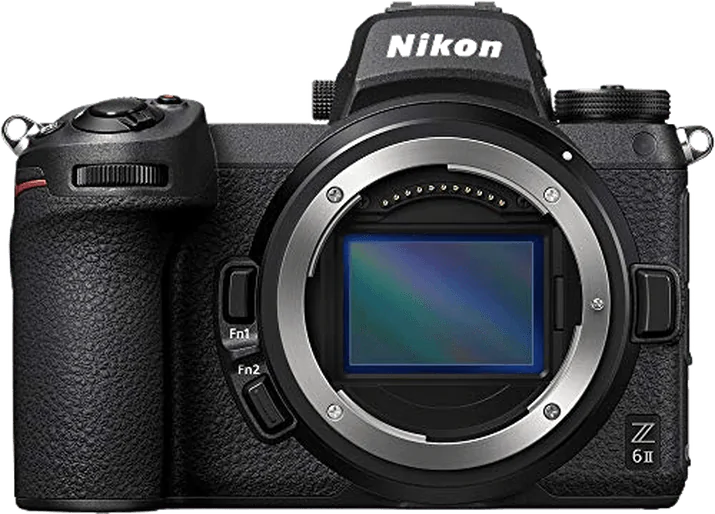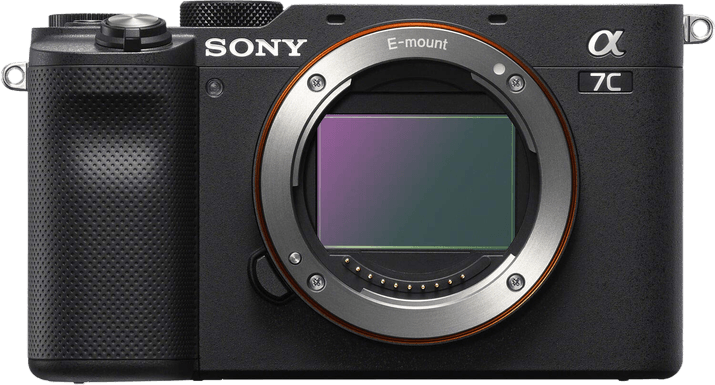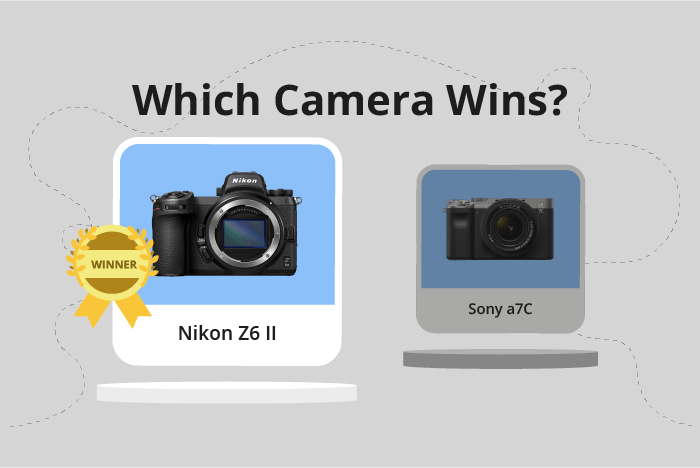Nikon Z6 II vs Sony a7C Comparison
Nikon Z6 II

Sony a7C

The Nikon Z6 II takes the lead with a score of 83/100, while the Sony a7C trails at 78/100. Both cameras are mirrorless, released in 2020, with the Nikon Z6 II announced on October 14th and the Sony a7C on November 1st. They share similar launch prices: $1995 for the Nikon Z6 II and $1799 for the Sony a7C.
Nikon Z6 II outperforms the Sony a7C with its larger size (134 x 101 x 70mm) and heavier weight (705g), providing better stability and grip for photographers. On the other hand, the Sony a7C is more compact (124 x 71 x 60mm) and lighter (509g), making it a more portable option for those who prioritize mobility.
Choosing between the two cameras depends on individual preferences. The Nikon Z6 II offers a more robust build and superior performance, while the Sony a7C is a lightweight alternative for photographers on the go.
Nikon Z6 II vs Sony a7C Overview and Optics
The Nikon Z6 II triumphs over the Sony a7C in the optics department with a score of 83/100 as opposed to the a7C’s 80/100. Both cameras share several specifications, such as having a CMOS sensor, Full Frame sensor size, and image stabilisation. Additionally, both cameras are equipped with their respective lens mounts – Nikon Z for the Z6 II and Sony FE for the a7C.
The Nikon Z6 II surpasses the Sony a7C with its 24.5 megapixels compared to the a7C’s 24.2 megapixels. This difference allows the Z6 II to capture slightly more detail in images. Furthermore, the Z6 II’s shooting speed of 14 frames per second is superior to the a7C’s 10 frames per second, enabling the Z6 II to capture fast-moving subjects with greater ease. The Dual Expeed 6 processor in the Z6 II also provides faster processing capabilities than the a7C’s Bionz X processor.
On the other hand, the Sony a7C holds a slight advantage in its DXOMARK sensor score, with 95 points compared to the Z6 II’s 94 points. This higher score reflects marginally better image quality and performance in the a7C’s sensor.
Taking these factors into account, the Nikon Z6 II emerges as the superior choice for those seeking better optics, with its higher megapixel count, faster shooting speed, and more powerful processor. However, the Sony a7C remains a strong contender, offering slightly better image quality through its higher DXOMARK sensor score. Ultimately, both cameras are excellent options, but the Nikon Z6 II takes the lead in the optics category.
Nikon Z6 II vs Sony a7C Video Performance
The Nikon Z6 II outperforms the Sony a7C in video capabilities, scoring 91 points compared to the Sony’s 70 points. Both cameras feature 4K video resolution and 3840 x 2160 video dimensions, ensuring high-quality video output. Additionally, both cameras have built-in time-lapse functionality, allowing for creative video possibilities.
The Nikon Z6 II excels with its maximum video frame rate of 120fps, providing smoother motion and the ability to create stunning slow-motion footage. This higher frame rate is a significant advantage for videographers and filmmakers who require fluid motion in their videos. The Sony a7C, on the other hand, has a maximum video frame rate of 30fps, which is sufficient for standard video recording but lacks the flexibility and creative options offered by the Nikon Z6 II.
While the Sony a7C falls short in frame rate, it does not have any specific advantages over the Nikon Z6 II in terms of video capabilities. The lower score of 70 points for the Sony a7C indicates that it is not on par with the Nikon Z6 II in this aspect.
Considering the video capabilities of both cameras, the Nikon Z6 II emerges as the clear winner with its higher video score and superior frame rate. Its 120fps frame rate offers more creative possibilities and smoother motion in videos, making it a better choice for videographers and filmmakers. While the Sony a7C shares some common features with the Nikon Z6 II, such as 4K resolution and time-lapse functionality, its lower frame rate and video score make it a less desirable option for those prioritizing video capabilities.
Nikon Z6 II vs Sony a7C Features and Benefits
The Nikon Z6 II wins the features comparison with a score of 87/100, while the Sony a7C scores 81/100. Both cameras share common specifications, including touchscreen capabilities, WIFI, and Bluetooth connectivity. Neither camera has GPS.
The Nikon Z6 II boasts a larger screen size of 3.2 inches, compared to the Sony a7C’s 3-inch screen. Additionally, the Z6 II has a higher screen resolution of 2,100,000 dots, providing a clearer and crisper display than the a7C’s 921,600 dots. This difference in screen size and resolution makes the Nikon Z6 II a better choice for photographers who value image clarity and detail on their camera’s display.
On the other hand, the Sony a7C has a flip screen, giving it an advantage in terms of versatility and ease of use for different shooting angles. The Nikon Z6 II lacks this feature, which could be a downside for some users. Despite this advantage, the a7C’s overall feature score is still lower than the Z6 II.
Taking these points into consideration, the Nikon Z6 II outperforms the Sony a7C in terms of features, primarily due to its larger screen size and higher resolution. This makes it a better choice for photographers who prioritize display quality. However, the Sony a7C’s flip screen offers more flexibility for various shooting situations, which could be a deciding factor for some users. It is essential to weigh these factors when choosing between the two cameras, as individual preferences and needs will determine the best option.
Nikon Z6 II vs Sony a7C Storage and Battery
The Nikon Z6 II takes the lead in storage and battery with a score of 71/100, while the Sony a7C trails behind at 45/100. Both cameras share some common specifications, such as being compatible with UHS-II memory cards and offering USB charging.
The Nikon Z6 II outperforms the Sony a7C with its dual memory card slots, accepting both SD and CFexpress Type B / XQD cards. This provides greater flexibility and backup options for photographers. However, the Z6 II falls short in battery life, offering 410 shots per charge with its EN-EL15c battery.
On the other hand, the Sony a7C boasts an impressive 740 shots per charge using its NP-FZ100 battery, but has only one memory card slot, accepting SD / SDHC / SDXC cards. This limits storage options and backup capabilities compared to the Nikon Z6 II.
Considering the above points, the Nikon Z6 II’s superior storage options make it a better choice for photographers requiring more flexibility and backup options. However, the Sony a7C’s longer battery life may appeal to those prioritizing extended shooting sessions.
Nikon Z6 II vs Sony a7C – Our Verdict
Are you still undecided about which camera is right for you? Have a look at these popular comparisons that feature the Nikon Z6 II or the Sony a7C:

